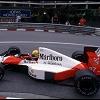
smaller brakes in F1....
#1

Posted 18 May 2010 - 03:54
but, that being said, one of the big issues for me in modern f1, is the brake efficiency... drivers are braking from 300 to 140, in under 90m......... the brakes should stay the same but be made smaller...
an F1 car is around 5m + -.... to outbrake someone in 90m, you need to be almost 10% better on the brakes, to cover the distance of their car.... that ain't going to happen....
smaller brakes, and the cars need to brake at 150m, giving the driver behind a greater chance of outbraking....
anyone else agree? ive just never heard this discussed, except by Todt a few years ago...
(also, i think drivers should be allowed to adjust their front wing all the time, to deal with the understeer, and front wings should be massively simplified)
Advertisement
#2

Posted 18 May 2010 - 03:57
#3

Posted 18 May 2010 - 03:58
Edited by Simon Says, 18 May 2010 - 03:58.
#4

Posted 18 May 2010 - 04:09
For example (made up numbers to make a point)
Todays' corner speed: 250KPH
Corner speed in the past: 220KPH
Todays' straight speed: 300KPH
Straight speed in the past: 330KPH
Where they used to have to slow down by 110kph, now its just 50kph. The reason is they have more grip then ever, but probably the weakest engines of the modern era.
#5

Posted 18 May 2010 - 04:18
The problem with the braking zone is that they have almost no speed to shed anymore.
For example (made up numbers to make a point)
Todays' corner speed: 250KPH
Corner speed in the past: 220KPH
Todays' straight speed: 300KPH
Straight speed in the past: 330KPH
Where they used to have to slow down by 110kph, now its just 50kph. The reason is they have more grip then ever, but probably the weakest engines of the modern era.
yes, another good pt..... i mean, 20 years ago, F1 had 1300HP + in quali, and 1000 in the race.... 5 years ago, 950hp.... straight line speed was where F1 should be...
now we're at around 740 (less than nascar and indycar which i both watch), and in 2011 , they're talking about 670???!!!
more HP, smaller brakes, simplified wings...
but this thread was about brakes
#6

Posted 18 May 2010 - 12:48
I think what's needed is a material that is less efficient but at least as reliable as the current ones.
#7

Posted 18 May 2010 - 13:23
in f1 you pretty much use them as hard as you can all race without issue...
oh and the current indycars have around 650hp :\
#8

Posted 18 May 2010 - 13:29
#9

Posted 18 May 2010 - 13:58
#10

Posted 18 May 2010 - 17:46
#11

Posted 18 May 2010 - 20:02
Smaller brakes + Bigger engines = Overtaking
Not with current aero packages. Bigger engines just mean more dependence on aero in corners, which means getting no where near the car in front.
There was more passing in F1 with much weaker engines and bigger brakes.
#12

Posted 18 May 2010 - 20:20
1. Shorter braking distances meanse more time in the slipstream
2. Better braking efficiency means you have a better chance of saving it if you overcook your entry. It's easier to pull out of an optimistic maneouvre. I look at champ car (is it indy car now? Well, at least when CART was CART) and Nascar as my references. Overtaking in champcar has been increadibly difficult since the mid 90's; they had no bargeboards, small wings, skinny tyres and steel brakes. In either series, we see lots of incidents when overtaking because once you commit, there's really no opportunity to pull back. The cars just won't stop!
I'm honetly stumped for answers, but looking back at last year before everybody had a DDD, there actually was some passing going on. I'd reserve more judgement until next year when that device is outlawed. Maybe we just need to accept that overtaking is just very difficult in F1. It's always been that way, although it was a lot easier to follow somebody to set them up for the pass.
#13

Posted 18 May 2010 - 20:21
The nose and rear wing designs would vary in the 3 designs from a high nose, to a low nose and teams could pick which one suits their car best and the rear wing will be roughly the same as an indycar wing so back to proper width but with minimal elements and again a choice of wing which has say either 1, 2 or 3 elements.
Teams would be allowed to change wing set up 3 times in the year, so if for the first third of the year, their chosen wing does not seem to work as well, they can change to one of the other option wings...
It would certainly spice things up a bit, reduce costs, and increase overtaking, of that I have no doubt...
#14

Posted 18 May 2010 - 20:43
The problem with the braking zone is that they have almost no speed to shed anymore.
For example (made up numbers to make a point)
Todays' corner speed: 250KPH
Corner speed in the past: 220KPH
Todays' straight speed: 300KPH
Straight speed in the past: 330KPH
Where they used to have to slow down by 110kph, now its just 50kph. The reason is they have more grip then ever, but probably the weakest engines of the modern era.
I'd like to know of any 250kph corners that are seen as passing opportunities under braking. Today or ever.
The good passing opportunities come at the 100-150kph corners after long, 300kph+ straights. But even shedding 150kph+ (100mph+) of speed is managed by an F1 car in a very short distance and time (I don't have figures to hand but it's less than 100m, less than 2 seconds on the brakes). Assuming you are nose-to-tail, to get an extra 5m advantage to get alongside requires 5% more braking performance, or an extra tenth of a second in reaction time. That is virtually impossible to find when all the cars run the same tyres and similar brakes, and all the drivers are of the highest standard. And that example is based on the very clearest manufactured passing points, for example the end of the very long straight at Abu Dhabi.
Decrease braking performance by 50%, and that margin increases by 50%. Not a revolution, but a significant step forward. I don't believe safety concerns are significant any more around modern tracks with wide, grippy run-offs.
It's part of the common sense package that will improve the racing in Formula 1. Alongside significantly decreased and simplified wing surfaces. Most observers of F1 have been saying this for the last decade or more, yet the sport itself seems unable to recognise it. Instead we have had a string of failed and gimmicky attempts to improve the "show", the climax of which has been the disastrous OWG rules which sprouted double diffusers and front wings that generate more downforce than the winglets and chimneys they were intended to replace.
#15

Posted 18 May 2010 - 20:55
Not with current aero packages. Bigger engines just mean more dependence on aero in corners, which means getting no where near the car in front.
There was more passing in F1 with much weaker engines and bigger brakes.
when did F1 have weaker engines? the 60's??
the 80's , we went up to 1500hp from the BMW engine, with most engines in the race over 1000...
now we're at 740, with the FIA talking about 670 in the future....
, and im not against carbon fibre brakes, just make them a bit smaller
#16

Posted 18 May 2010 - 20:56
nascar limits brake cooling and other things to limit brake effiecency
in f1 you pretty much use them as hard as you can all race without issue...
oh and the current indycars have around 650hp :\
do they break in nascar? aha
#17

Posted 18 May 2010 - 21:02
I'd like to know of any 250kph corners that are seen as passing opportunities under braking. Today or ever.
The good passing opportunities come at the 100-150kph corners after long, 300kph+ straights. But even shedding 150kph+ (100mph+) of speed is managed by an F1 car in a very short distance and time (I don't have figures to hand but it's less than 100m, less than 2 seconds on the brakes). Assuming you are nose-to-tail, to get an extra 5m advantage to get alongside requires 5% more braking performance, or an extra tenth of a second in reaction time. That is virtually impossible to find when all the cars run the same tyres and similar brakes, and all the drivers are of the highest standard. And that example is based on the very clearest manufactured passing points, for example the end of the very long straight at Abu Dhabi.
Decrease braking performance by 50%, and that margin increases by 50%. Not a revolution, but a significant step forward. I don't believe safety concerns are significant any more around modern tracks with wide, grippy run-offs.
It's part of the common sense package that will improve the racing in Formula 1. Alongside significantly decreased and simplified wing surfaces. Most observers of F1 have been saying this for the last decade or more, yet the sport itself seems unable to recognise it. Instead we have had a string of failed and gimmicky attempts to improve the "show", the climax of which has been the disastrous OWG rules which sprouted double diffusers and front wings that generate more downforce than the winglets and chimneys they were intended to replace.
There really is no 'reaction time' so to speak. The driver already has a very good idea of where his braking point is, so I imagine he gets to it, and then hits the brakes....
#18

Posted 18 May 2010 - 21:05
I agree that the breaks should be weaker but i don't think smaller breaks are they way to go. That would mean more overheating and failures.
I think what's needed is a material that is less efficient but at least as reliable as the current ones.
Not quite... Tell that to Lewis Hamilton, or Vettel last race.
I'm probably fighting a losing battle here.
#19

Posted 18 May 2010 - 21:09
There really is no 'reaction time' so to speak. The driver already has a very good idea of where his braking point is, so I imagine he gets to it, and then hits the brakes....
If you have put a driver under pressure, or off line, he has to adapt. He won't brake exactly the same way. Longer braking distances let the following driver take advantage of that, the challenger has more time to make a move, and any misjudgement by the leader will cost him more ground.
Advertisement
#20

Posted 18 May 2010 - 22:03
I'd like to know of any 250kph corners that are seen as passing opportunities under braking. Today or ever.
The good passing opportunities come at the 100-150kph corners after long, 300kph+ straights. But even shedding 150kph+ (100mph+) of speed is managed by an F1 car in a very short distance and time (I don't have figures to hand but it's less than 100m, less than 2 seconds on the brakes). Assuming you are nose-to-tail, to get an extra 5m advantage to get alongside requires 5% more braking performance, or an extra tenth of a second in reaction time. That is virtually impossible to find when all the cars run the same tyres and similar brakes, and all the drivers are of the highest standard. And that example is based on the very clearest manufactured passing points, for example the end of the very long straight at Abu Dhabi.
Decrease braking performance by 50%, and that margin increases by 50%. Not a revolution, but a significant step forward. I don't believe safety concerns are significant any more around modern tracks with wide, grippy run-offs.
It's part of the common sense package that will improve the racing in Formula 1. Alongside significantly decreased and simplified wing surfaces. Most observers of F1 have been saying this for the last decade or more, yet the sport itself seems unable to recognise it. Instead we have had a string of failed and gimmicky attempts to improve the "show", the climax of which has been the disastrous OWG rules which sprouted double diffusers and front wings that generate more downforce than the winglets and chimneys they were intended to replace.
The speed numbers in my post are irrelevant. The point was that they travel slower in a straight line today, but faster in the corners. It simply means they have much shorter braking zones then what they used to (and sometimes no braking zone at all. What was once a corner is now a high speed flat out curve).
#21

Posted 18 May 2010 - 22:17
If you have put a driver under pressure, or off line, he has to adapt. He won't brake exactly the same way. Longer braking distances let the following driver take advantage of that, the challenger has more time to make a move, and any misjudgement by the leader will cost him more ground.
Choosing braking points is purely about judgement. Barring the occaional oil slick or water puddle, or broken spring or avoidance maneouvres, I don't have the slightest clue about what you'd be reacting to. I choose the insid line, or outside line, and then make a judgement to adjust for variables like speed, line, grip, etc, but what would I be reacting to? Where would reaction times come into play? Please advise...
Regarding the 5% and 5m argument, the only time I see reactions being a deal (regarding that specific case you mentioned) is if you're hell bent on braking later than your opponent. I recall Montoya vs. Schumacher in Austria 2001, I believe.
It's called driving with your mirrors, and usually ends in disaster. Schumacher showed montoya how to do it in Spa, 2004, when he got passed on the outside into bus stop
Edited by BMW4life, 18 May 2010 - 22:24.
#22

Posted 18 May 2010 - 23:01
Parts break in NASCAR all the time.do they break in nascar? aha
#23

Posted 18 May 2010 - 23:14
Parts break in NASCAR all the time.
crap why did i write break





















